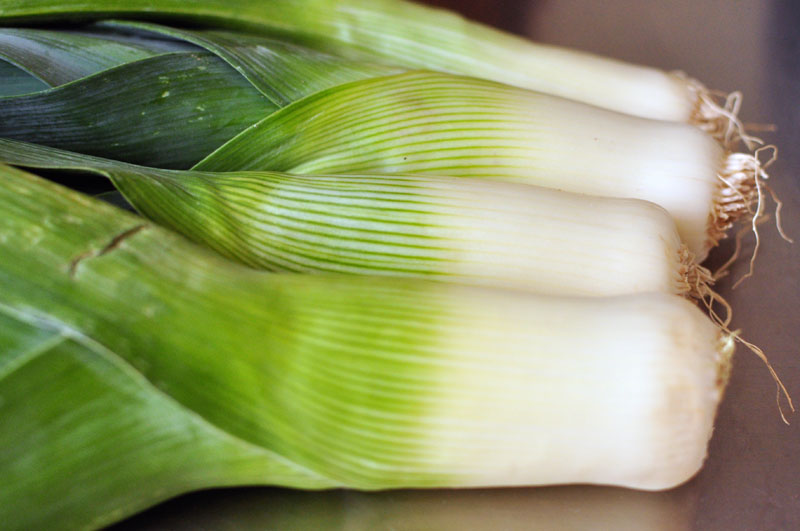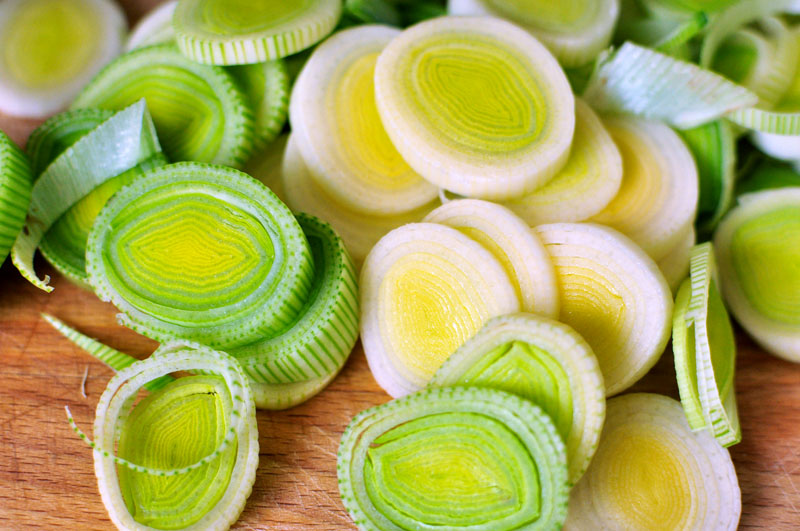It figures that we would kick off this new project with leeks. They are not so different from the ingredients in our chosen monikers, as leeks are in the same family as both garlic and onion.
January’s a cold month, and we decided that something that would help us warm up was an ingredient we know we’d love. We’ve had a little experience with leeks before, when we made Pioneer Woman’s Leek and Potato Pizza. We’ve been flirting with them ever since.
 Leeks are a root vegetable, but unlike garlic and onion, whose edible parts are the tight bulb they form in the ground, leeks consist of a long edible stalk. This stalk ranges from white to green, almost like a fat scallion. However, they are much milder than a scallion, especially the white parts. Traditionally, only the white parts are eaten, but the green is perfectly edible, just a bit more bitter. But don’t toss them out – the left over green stalks make great additions to a soup stock, or in a stir fry.
Leeks are a root vegetable, but unlike garlic and onion, whose edible parts are the tight bulb they form in the ground, leeks consist of a long edible stalk. This stalk ranges from white to green, almost like a fat scallion. However, they are much milder than a scallion, especially the white parts. Traditionally, only the white parts are eaten, but the green is perfectly edible, just a bit more bitter. But don’t toss them out – the left over green stalks make great additions to a soup stock, or in a stir fry.

We think of leeks as a winter vegetable, but it turns out they are so hearty they can be harvested almost any time. They generally reach maturity in the autumn months, but many varieties are sturdy enough that they can be left in the ground through winter to be harvested as needed. That’s why they seem so abundant in the colder months when you’re desperately foraging for something green in your local produce aisle!
Since they belong to the same family as garlic and onion, leeks provide many of the same health benefits as our other favorite vegetables. In particular, they provide cardiovascular benefits by being rich in kaempferol which protects our blood vessel linings from damage, as well as the B vitamin (folic acid) which is key to cardiovascular health because it helps manage your levels of homocysteine (elevated homocysteine levels are often found in patients with cardiovascular disease). Not to mention, leeks are rich in antioxidants like their garlic and onion siblings. Check out WHFoods.org for some great information on the health benefits of leeks and other foods, as well as some prep and storage tips!
Leeks have a long history dating back to ancient Central Asia, Greece, Rome, and Egypt. There is actually an Egyptian variety known as a Kurrat that archaeologists believe may have been a part of the Egyptian diet since the 2nd century BCE. It is believe that the Romans introduced leeks to the United Kingdom, at which point they were adopted into the local cuisine, because they turned out to be hearty enough to withstand the cool weather. In Wales, the leek serves as the national emblem, and with their elevated status, leeks have become a staple in the Welsh diet.
Because of their mild flavor, leeks make an excellent substitute for onions when dealing with picky eaters or dishes with more delicate flavor profiles in which you don’t want to overpower any of the other flavors with a strong onion. You can eat them almost any way you like, including raw, boiled, fried, sauteed, or in a salad.
 Here are a few recipes that caught our eye. We’d recommend trying one of these sometime!
Here are a few recipes that caught our eye. We’d recommend trying one of these sometime!
Check out the NY TImes Leek Recipes for Health
Fish with Creamy Leeks at Epicurious
A Potato, Leek, and Feta Tart from our favorite recipe creators at Real Simple
In our research, we noticed that leeks are most commonly paired with potatoes, fish, bacon, and dishes heavy in cheese and starch. For our purposes, we’ve chosen to try our hand at one recipe that fulfills each of these requirements. This week, we will both be making our own version of a bacon and leek quiche and report back to you. Then, Jennie will investigate this leek and fish recipe trend while I go the more traditional route and make my grand memere’s potato leek soup!
Stay tuned for quiche – here’s a sneak peek at mine!
[addtoany] Yum

